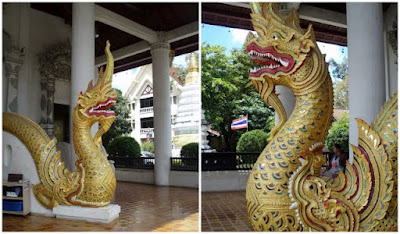Twin nagas (sacred serpents) stand watch at the door to the wihan (hall).
The temple was quite busy today. It was supposed to be a local holy day, but I couldn't figure out what it was specifically.
It is decorated with elephants (chang) around the base and nagas at the foot of the four stairways.
Other scenes from around the wat:
We then left Wat Chedi Luang and walked through the Old City to another nearby temple, Wat Phra Sing. It is the largest temple in Chiang Mai. The Wihan Luang (Great Hall) is very large and houses an equally large Buddha statue inside.
Inside, along one of the aisles, a monk in orange robes was chanting blessings over the faithful.
Another wihan, the Wihan Lai Kham (Gilded Hall), is one of the most visited areas of the temple complex. It contains the Phra Buddha Singh (Lion Buddha), a very important Buddha image.
 |
| Wihan Lai Kham with small chedi |
The Lion Buddha originated in Sri Lanka, and is revered in Chiang Mai. Every year, the statue is carried through the streets of the city for the Songkran festival.
The rest of the temple complex was very lovely.
After lunch we walked around a bit more. The Old City of Chiang Mai is square shaped, with walls and a moat marking its borders. The walls and gates are old and were dismantled over time. But the Tha Phae gate has been reconstructed based on old photographs and drawings.
This is a view of the moat and a corner of the city wall that has been preserved.

















No comments:
Post a Comment